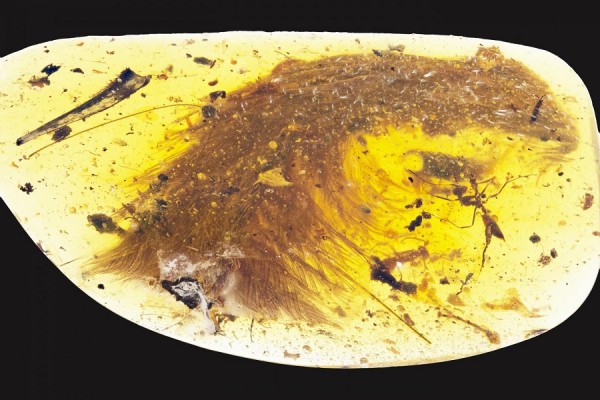By Ana Verayo, | December 09, 2016

This photograph shows the tip of a preserved dinosaur tail section, showing carbon film at its surface exposure, and feathers arranged in keels down both sides of tail. (RSM/ R.C. McKellar)
In an incredible fossil discovery, scientists have found a baby dinosaur feathered tail preserved in amber. In the past, scientists have found dinosaur feathers encased in amber. However, this is the first time that the bone and soft tissue of a dinosaur have also been found preserved with feathers.
Like Us on Facebook
This nearly 100 million years old fossilized tail apparently belongs to a theropod, a juvenile coelurosaur dinosaur.
Chinese and Canadian scientists described these feathers as densely packed together. They were not necessarily used for flight. The team suggests that these feathers were most likely used for regulating body temperatures and communicating with others.
The team believes that these feathers belong to a dinosaur and not a prehistoric bird, due to the anatomy of the tail bone and its thick feathers.
According to the co-author of the study, Ryan McKellar of the Royal Saskatchewan Museum in Canada, this tail belongs to a dinosaur since the vertebrae are not pygostyle or fused into a rod-like modern birds possess. This tail is long and flexible. It also contains keels of feathers on each side.
This exquisite amber fossil was obtained by paleontologist Lida Xin of the China University of Geosciences in Beijing while scouring through an amber market in Myanmar in 2015.
Xing explained that he never expected a dinosaur in amber after studying dinosaurs and paleontology for 10 years. He noted that this had been his coolest find yet.
The team described the pristine feathers as serving a decorative purpose since feathers used for flight possess a sturdy central shaft with branches and sub-branches where the smaller sub-branches have hooks that bind the feather in one piece.
However, the feathers inside the amber possessed hooks and appear soft and droopy. They are also loosely combined without this central stem.
This new study was published in the journal Current Biology.
-
Use of Coronavirus Pandemic Drones Raises Privacy Concerns: Drones Spread Fear, Local Officials Say

-
Coronavirus Hampers The Delivery Of Lockheed Martin F-35 Stealth Fighters For 2020

-
Instagram Speeds Up Plans to Add Account Memorialization Feature Due to COVID-19 Deaths

-
NASA: Perseverance Plans to Bring 'Mars Rock' to Earth in 2031

-
600 Dead And 3,000 In The Hospital as Iranians Believed Drinking High-Concentrations of Alcohol Can Cure The Coronavirus

-
600 Dead And 3,000 In The Hospital as Iranians Believed Drinking High-Concentrations of Alcohol Can Cure The Coronavirus

-
COVID-19: Doctors, Nurses Use Virtual Reality to Learn New Skills in Treating Coronavirus Patients







